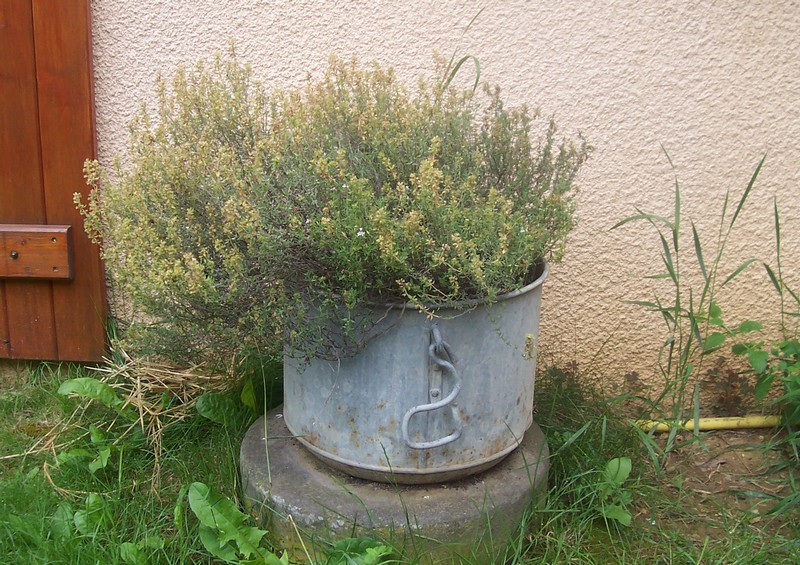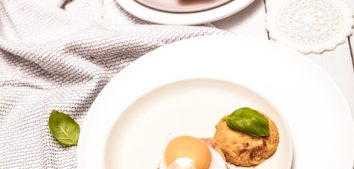
Herbs in the home – THYME
Spring has come! We can seed! Unfortunately, my lifestyle excludes me from owning a herbal garden.
But all of you who possess one or are at least happy
balcony owners are cordially advised to grow herbs. Especially seasoning herbs. Fresh leaves added to a dish will enrich flavor and aroma in an extraordinary
way. What is more, they are a lot healthier than their equivalents.
Today, I recommend Thyme.Thymus vulgaris is a low shrub growing up to 30-40 centimeters. Its shoots are
small, four-angular, red-brown, lignified at the bottom. It blooms in June and July. The plant has a peculiar, nice but pungent, thymol smell. It is classed as a
remarkably melliferous. Thyme is best to be grown as an annual plant. We sow it near the surface 0.5 gm of seeds per 1 square meter in rows every 30 cm. The
seeds germinate after 10 days and from that time we need to weed the bed well till the plants develop watering them systematically. The first herbs should be
cut at 10 cm above the ground in June so that we could collect new shoots at the beginning of October. Thyme shoul be dried scattered in a thin layer; later, we
crumble it removing lignified parts. Dried herbs should be stored in linen bags.
Thyme is one of the oldest seasoning herbs. This is what I found in the bookZiółka i myby I. Gumowska: “In the contemporary cuisine thyme is used mostly
to season meat – roast beef, pork, liver, stuffing (eg dumplings), meat patties, roast poultry and fish, sauces and dressings, goulash and pâté, sometimes to
grilled dishes. Moreover, we add it to broth and other soups as well as to marinades, herbal vinegar, when making pâtés and cold meats, marinating and
pickling cucumbers. It is also beneficial when added to every dish with dried or stewed totatoes or with tomatoes generally (…). The flavor and aroma of thyme
blends well with legumes dishes. A pinch of thyme added to bean soup, pea soup, baked beans in tomato sauce, pea with cabbage will enhance the flavor of
those dishes considerably.”
Thyme as a medicinal plant. In preserves with thyme its expectorant effect is mostly used as thyme stimulates spontaneous movements of cilia on epithelium in the upper respiratory tract. It increases secretion of mucus diluting thick discharge filling the throat, which makes it easier to cough up. Flavonoids of thyme have an diastolic effect, which is beneficial in the coughing up action.
Phenolic constituents of oil such as thymol and carvacrol as well as tannin and other compounds included in the herb inhibit the growth of fungi and bacterial
flora. Especially streptococci in the oral cavity and throat, the digestive system and skin.
Bitter compounds of the herb stimulate secretion of stomach acid and improve digestion as well as absorbing food. Other elements relieve muscular
contractions in the digestive system. Thyme infusion: pour 1 tbs of thyme with 1 ½ glass of boiling water and brew
in a covered dish for about 15 minutes. Leave it for another 15 minutes and then drain it off. Drink 1/3 glass 2 or 3 times a day after meal as a remedy to
control digestion and preventing flatulence. It can be used to boost your appetite or as an expectorant remedy between meals. The same infusion can be used to
gargle the throat in tonsillitis.
Thyme bath: 1100 g of thyme pour with 5 l of warm water and boil in a covered dish for 3 minutes. Leave it for another 15 minutes and then drain it off. After draining the herb off, put it into a linen bag, tie the bag up and put it into the bath together with the decoction. The bath should be filled with water in 1/3 and
the temperature should be around 37°C . The time of a bath – from 10 to 15 minutes. It helps to relieve pain, it is anti-inflammatory and helps to regenerate
skin.
Thyme lotion: 50 g of thyme boil in a covered dish on a low heat for a dozen or so minutes in a liter of water. Leave the decoction for 15 minutes in a covered
dish, then, drain it off and rub it into hair and skin 10 minutes before you are going to wash your hair. According to Andrzej Skarżyński, such therapy stops
hair from falling out, strengthens skin and removes dandruff.
Source:
- Ożarowski A. Jaroniewski W. – Rośliny lecznicze i ich praktyczne zastosowanie
- A. Skarżyński – Zioła czynią cuda
- B. Kuźnicka M. Dziak – Zioła i ich stosowanie










Comments No Comments
Join the discussion…